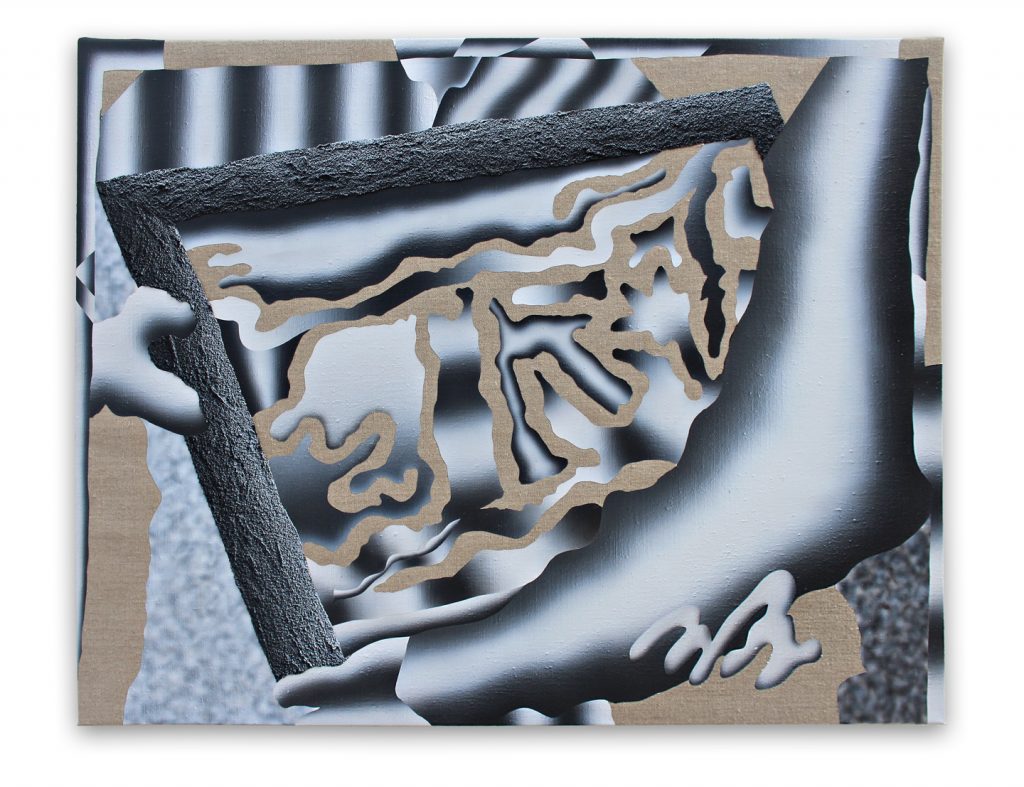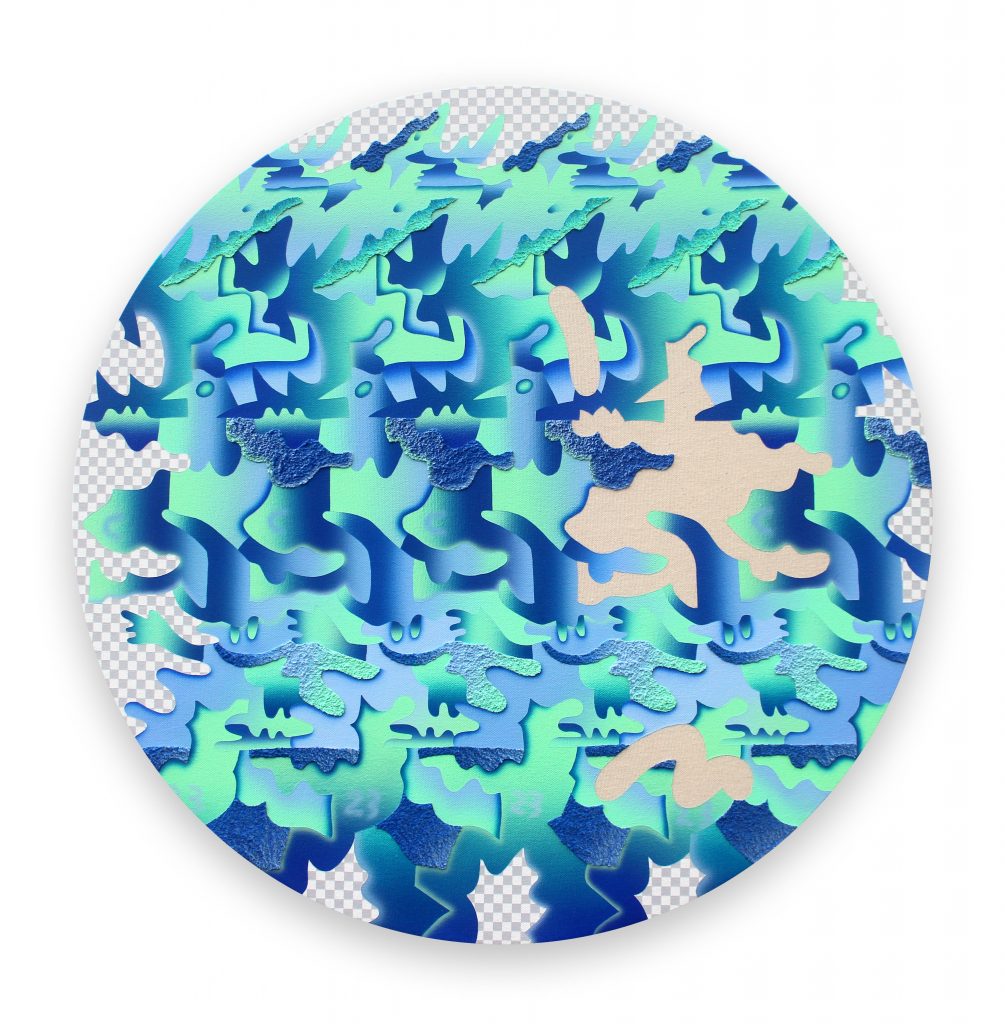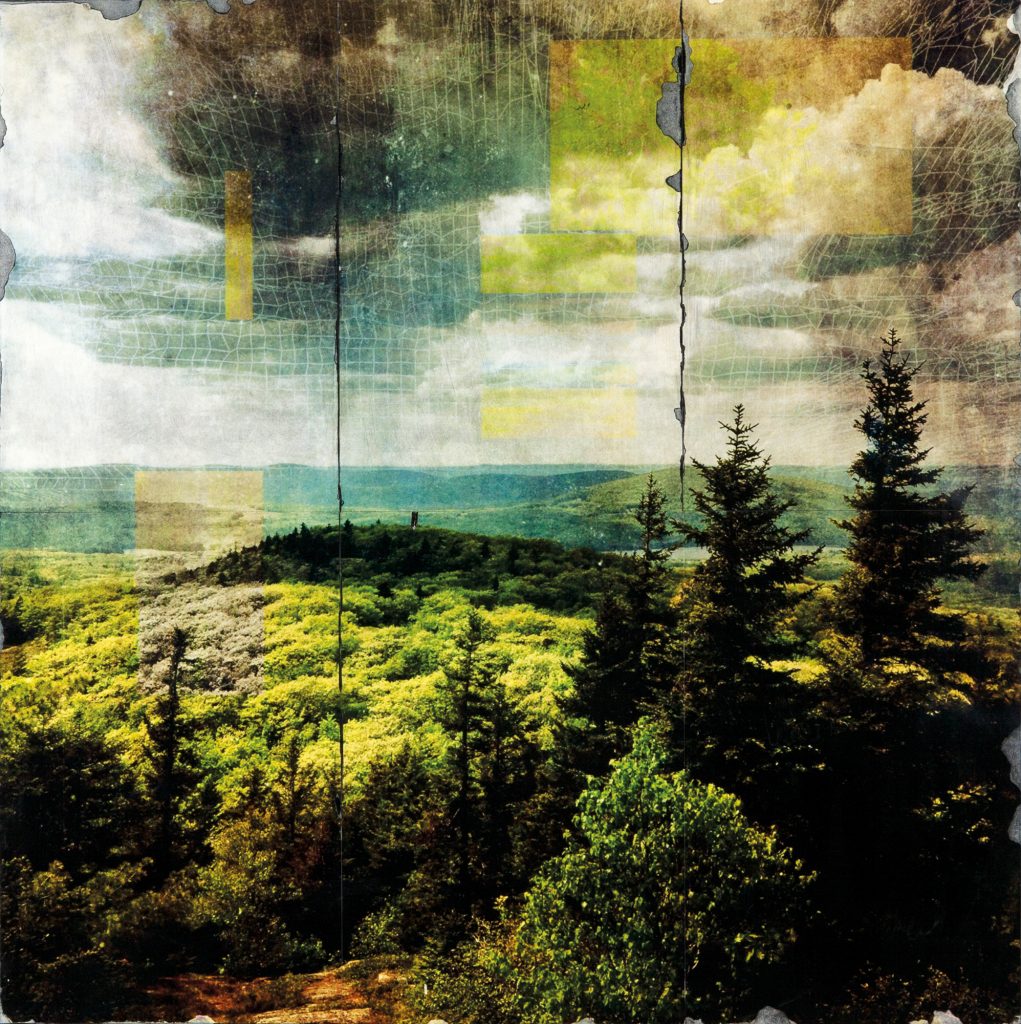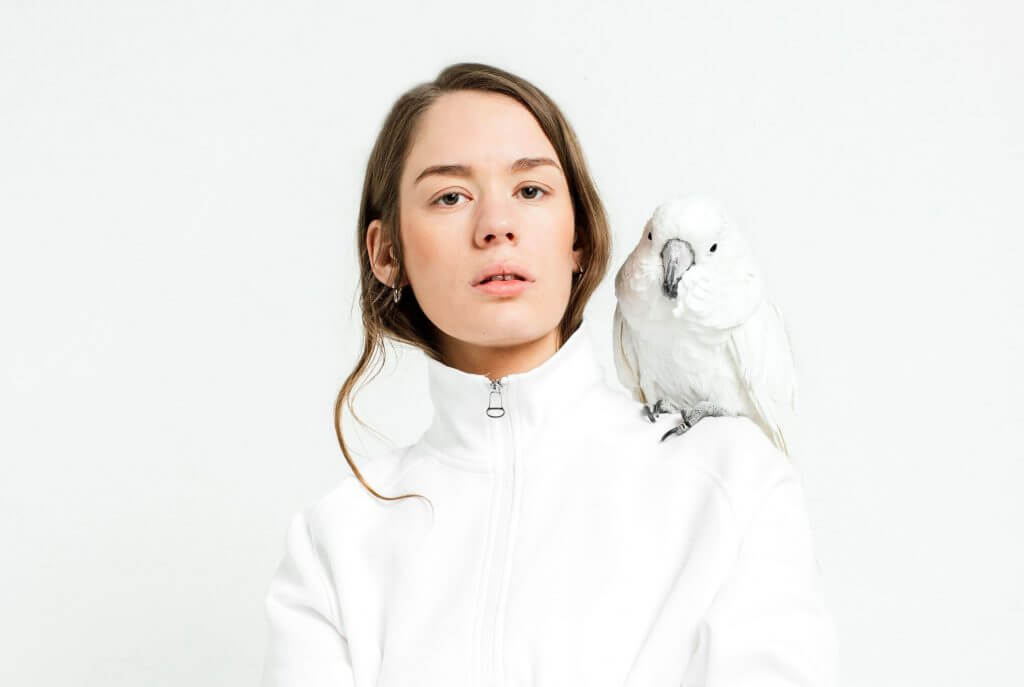Morgan Blair: From Seinfeld To Abstraction


“At the core, I always seem to want to make an image that’s hard to look at but also locks you in, like Anna Nicole Smith and Barney Rubble riding a Coney Island hot dog purchased from George’s Coney Island in Worcester, MA into the sun,” explains painter Morgan Blair. There’s no better way to describe Blair’s hallucination inducing, vibrantly colored and maddeningly patterned paintings.
Part Magic Eye, part vintage Zubaz pants, Blair’s fluorescent paintings reflect both an unmistakable nostalgia for the 1990s and our contemporary digital age. Much of this comes from her choice to source her imagery from screenshots as varied as “how-to” videos on YouTube and Seinfeld clips. Not that you would know on immediate glance. Looking to create a “dense pattern and optical space,” Blair rearranges and reconfigures these images in Photoshop and proceeds to translate them onto canvas–gesso-ing, taping off shapes, filling in with airbrush gradients and repeating the entire process again. The end result is a multidimensional, amorphous but inexplicably pop culture-infused neon world.
I first encountered Blair’s paintings at Victori + Mo’s summer 30 Under 30ish exhibition where her painting almost vibrated off a crowded wall It also had a hysterical mouthful of a title: Post Plastic Surgery Nuclear Meltdown Evening Ski Constitutional On Jupiter With Marshalls Applewhite, Halloween 2069. Inspired by the work, I met with Blair at her joint apartment/studio in Ridgewood where she carefully pulled tape off a new palm tree-filled painting as two kittens and their long-suffering mother threatened to jump on the canvas.
I later spoke to Blair via email after her completion of a major monumental mural outside Mechanics Hall in Worcester, MA about how she choses the initial screenshots that become her paintings, the influence of Seinfeld on her art and her new jigsaw puzzle art project, Puzzle Time.

When did you initially begin working with screenshots as source materials? Similarly, what are some of these videos or materials? Do you purposefully look out for these sources or is it just random?
I was taking a lot of screenshots from episodes of Seinfeld in order to make drawings and oil paintings from them. I started to be drawn to shots where there’s a close-up of someone’s hand holding an object, where there’s a quick pan between shots and a character’s back is turned, or where no character present but there’s a bunch of background stuff sitting there. There’s often a mysterious feel to those moments, where there’s not much context or reference to familiar faces. The visual elements aren’t composed in the same way as in the rest of the show and we’re left with these cryptic scenarios that I’m interested in as sort of disembodied blips of narrative.
This idea came up again in watching tutorial and instructional videos on YouTube, in which there are a myriad of weird close-ups, hands doing unrecognizable tasks, out-of-focus shots and so on. I like those amateur videos for all the endless frames of strangely composed imagery they have to draw from. I also sometimes look through Craigslist free stuff and eBay for similar photos.


Before your current body of work, you created a series of more realistic paintings based on Seinfeld. However now, you still use screenshots from Seinfeld in your paintings, but they’re just more obscured. Why did you start the series of Seinfelds and how do you see it related to your more recent work? What is it about Seinfeld in particular that inspires your paintings?
I was looking for a way to dislodge myself from a sort of creative rut. I thought it would be funny to do oil paintings of scenes from Seinfeld–I don’t remember why. At a loss for a way to move forward with my usual style of work, I figured I would just walk blindly into left field with these Seinfelds, embark on a totally different process, style and subject matter and hope to find something in there that would tie into my other work and lead me in a new direction. It seems the thing I’ve held onto is the use of screenshots as a jumping off point for narrative and compositional elements. Seinfeld inspires my paintings–consciously or subconsciously–by virtue of having been hugely influential to and affirming of my particular sense of humor and fixation on minutia, visually and socially.

Beyond Seinfeld as an influence, you’ve also referenced Magic Eye books in your psychedelic abstractions. Both are these iconic 1990s cultural objects. Why do you think the 1990s remain important to your work?
I think that’s just when I was the most impressionable, and since it was before the Internet was the ubiquitous source of infinite entertainment that it is now, I was really glued to whatever I could find around me that appealed to my sensibilities. I never was obsessed with Magic Eye, but definitely experienced them. In looking back, it was probably my actual fixation on puzzles that informed my appreciation for patterns, which then retroactively brought me back around to Magic Eye. And with Seinfeld, I’m pretty sure that show and Paul Simon’s Graceland literally formed, or at least affirmed, my brain wiring.


The titles of your paintings are hilarious such as Gingerbread Woman 2016 Does What The Fuck She Pleases, Quaaludes on a Rainy Day. It adds this wonderfully absurd context to the work. What is the role of your paintings’ titles and what does it add for you?
Initially, I started coming up with them as a way to add some interest to these totally abstract paintings I had made that weren’t that great. I thought if I had these titles to contextualize them in some wacky narrative, with reference to certain shapes in the paintings as objects or characters, people would look at the paintings differently. Now, I like writing the titles without much regards to what’s actually going on in the piece, though I think they still serve to root these paintings of mostly arbitrary, abstracted imagery into specific, absurd narratives from an alternate reality. Basically, they’re jokes.

You mentioned your love of puzzles earlier. You’re also working on Puzzle Time–a series of hand-cut jigsaw puzzles that feature works by contemporary artists including yourself. How did you get into making art puzzles?
I grew up doing puzzles all the time. My grandfather on my mom’s side has been hand-cutting wooden jigsaw puzzles for decades. There are dozens of them at my grandparents’ house and at my parents’ house, so I would always end up doing a puzzle or five to pass the time while I was visiting them or as a group activity during Thanksgiving (or whenever). Some years ago, my uncle also started making hand-cut wooden jigsaw puzzles and turned out to be really good at it. He came to me with the idea of collaborating with artists so he could make and actually sell the puzzles with their work on them. He’d return part of the profit to the artist. I started planning how that could work. I thought it would be best to make the artist puzzles in small editions, with specific artists, certain sized puzzles, special wooden boxes, a website and a whole aesthetic. I think my idea of how it would go was more elaborate than what he had in mind, but I had become really invested in the idea. So I decided I wanted to learn to cut puzzles myself so I could go through with the project. With his guidance and expertise, I started gathering the tools and practicing cutting. You use these teeny tiny scroll saw blades for puzzle cutting. It’s so precise that I thought I would get discouraged right away, but actually I took to it without too much frustration.
So far I’ve only made the first edition, and used a piece of my own for the art so I could get the next project started and worked out any issues without dragging along another artist for the trial run. Next up is Ryan Travis Christian, whose work is insane and is going to be super challenging to put together. In keeping with tradition, no picture is provided with the puzzle so you have no reference to work from. I like this method because it forces you, as the puzzles putter-together, to be totally present in studying these works of contemporary art up close–in a different way from how you would look at them on the wall. You start to see how all the fragmented pieces of the image go together, literally, and from all directions. My hope is that people will appreciate these puzzles as unique, handmade art objects and gain a new perspective on pieces of art they already love or are getting to know for the first time. There’s my pitch!

Mural by Morgan Blair at Pacific Park on Dean Street in Prospect Heights, Brooklyn, New York.
Your work seems to reference the progression of digital images that we see everyday that we may not think about. Do you see your work addressing digital culture or are you more interested in pattern and form?
Right now, I’m solely focused on pattern and form with the imagery I draw from just being convenient and, sometimes, funny vessels for those elements. Much of the music I gravitate toward is super fast and dense with layers of rhythm and percussion overlapping to create these hyper-saturated cacophonies that also have complex underlying structures. That’s kind of what I’m going for in my work, or at least, I think that’s what’s at the root of it. And from there I stray off in different directions–experimenting with saturation, density and scale of pattern or degree of abstraction, etc.









Responses